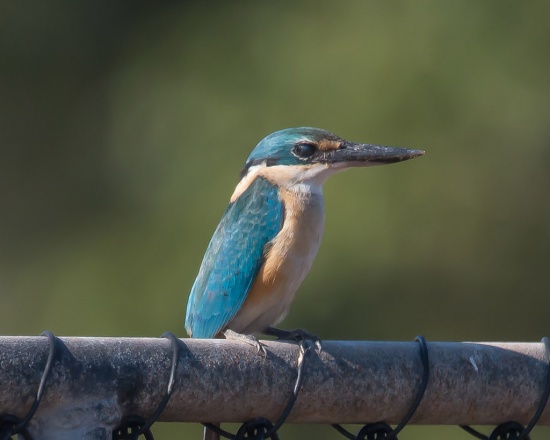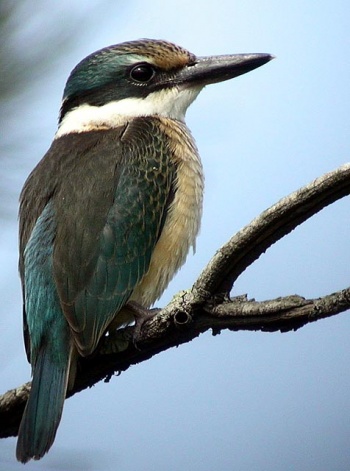- Todiramphus sanctus
Halcyon sancta, Todirhamphus sancta
Identification
22 cm (8¾ in)
- Turquoise back, rump and tail
- Buff-white underparts
- Broad cream collar
- Broad black eye stripe extending from bill to nape of neck
- Buff spot in front of eye
Sexes are similar, although the female is generally lighter with duller upper parts.
Distribution
Australia, Tasmania, New Zealand, Norfolk Island, Lord Howe Island, Loyalty, Kermadec & Solomon Islands, Futuna & Fiji Islands, New Caledonia.
Winters north to New Guinea, Indonesia & Melanesia.
Taxonomy
Subspecies

Photo © by Ken Doy
Norfolk Island, Territory of Australia, 3 May 2016
There are 4 subspecies[1]:
- T. s. sanctus:
- Australia to Solomon Islands; winters to New Guinea
- T. s. vagans (norfolkiensis, adamsi) :
- New Zealand, Norfolk, Lord Howe and Kermadec islands
While not exhibiting a significant difference from the New Zealand vagans, specimens found on Lord Howe Island and Norfolk Island are, at times, treated as a different race of adamsi and norfolkiensis respectively.
- T. s. canacorum :
- New Caledonia and Isle of Pines
- T. s. macmillani:
- Loyalty Islands
The subspecies vitiensis, eximius and regina of Collared Kingfisher are sometimes placed in this species.
Habitat
Woodlands, mangroves and paperbark forests, tall open eucalypt forest near water.
Behaviour
Diet
The diet mostly consists of crustaceans, reptiles, insects and their larvae and, occasionally, fish. Hunts from, and returns to, the same low, exposed perch.
Breeding
The nest hole is excavated by both sexes, normally in a termite mound, but could be a hollow branch or into the river bank. The unlined nest chamber can be as much as 20m above ground. Three to six eggs are laid and cared for by oth adults. The chicks hatch after about 18 days and leave the nest after a further 26 days.
References
- Clements, J. F., T. S. Schulenberg, M. J. Iliff, S. M. Billerman, T. A. Fredericks, B. L. Sullivan, and C. L. Wood. 2019. The eBird/Clements Checklist of Birds of the World: v2019. Downloaded from http://www.birds.cornell.edu/clementschecklist/download/
- Birds in Backyards
- Bird Forum Member observations
- Woodall, P. F. and G. M. Kirwan (2020). Sacred Kingfisher (Todiramphus sanctus), version 1.0. In Birds of the World (J. del Hoyo, A. Elliott, J. Sargatal, D. A. Christie, and E. de Juana, Editors). Cornell Lab of Ornithology, Ithaca, NY, USA. https://doi.org/10.2173/bow.sackin1.01
Recommended Citation
- BirdForum Opus contributors. (2024) Sacred Kingfisher. In: BirdForum, the forum for wild birds and birding. Retrieved 16 April 2024 from https://www.birdforum.net/opus/Sacred_Kingfisher
External Links
Search the Gallery using the scientific name:
Search the Gallery using the common name:
GSearch checked for 2020 platform.






